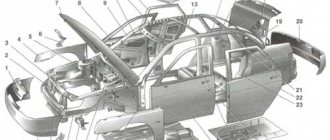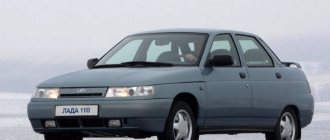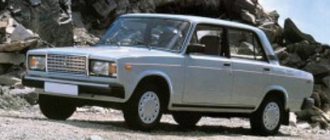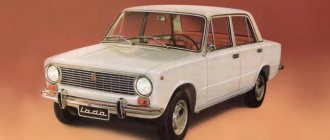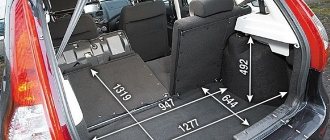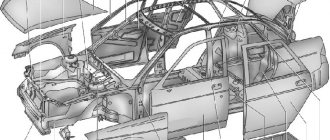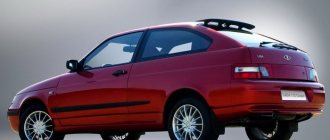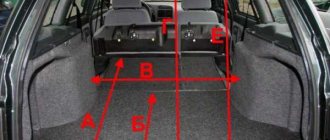How much does the VAZ 2106 body weigh and how does it affect acceleration?
VAZ 2106 body dimensions
How much does the VAZ 2106 body weigh and what are its dimensions? People often ask on forums and car portals. Indeed, interest in the most popular car in the post-Soviet space was and remains incredibly high. Find out more by reading useful information on the body of this car. A lot depends on how much it weighs, including the condition of the car’s basic parameters.
What is the weight of the VAZ 2106
VAZ 2106 body dimensions
How much does the VAZ 2106 body weigh and what are its dimensions? People often ask on forums and car portals. Indeed, interest in the most popular car in the post-Soviet space was and remains incredibly high. Find out more by reading useful information on the body of this car. A lot depends on how much the body of the VAZ 2106 weighs, including the condition of the main parameters of the car.
Body
| Number of doors | 4 |
| Number of seats | 5 |
| Wheelbase | 2424 mm |
| Front track | 1365 mm |
| Rear track | 1321 mm |
| Ground clearance | 170 mm |
| Maximum trunk volume | 345 l |
| Width | 1611 mm |
| Length | 4166 mm |
| Height | 1440 mm |
Engine
| Engine capacity | 1569 cm 3 |
| Power | 75 hp |
| At rpm | 5400 |
| Torque | 116/3000 n*m |
| Gas distribution mechanism | OHC |
| Number of cylinders | 4 |
| Number of valves per cylinder | 2 |
| Cylinder diameter | 79 mm |
| Piston stroke | 80 mm |
| Compression ratio | 8.5 |
Performance indicators
| Maximum speed | 150 km/h |
| Acceleration time (0-100 km/h) | 17.5 s |
| Fuel consumption in the city per 100 km | 10.1 l |
| Fuel consumption on the highway per 100 km | 7.4 l |
| Combined fuel consumption per 100 km | 10.1 l |
| Fuel tank volume | 39 l |
| Vehicle curb weight | 1035 kg |
| Permissible gross weight | 1435 kg |
| Tire size | 175/70 SR13 |
Other
VAZ 2106 2106 1.6 MT is a 4-door car with a 4-speed gearbox. With the number of seats for the driver and passengers: 5. The maximum permissible speed is 150 km/h. Acceleration time to 100 km/h is 17.5 s. Average fuel consumption per 100 km is: in the urban cycle - 10.1 liters, on the highway - 7.4 liters, in the combined cycle - 10.1 liters. Maximum fuel tank volume is 39 l. A full tank is enough for approximately: 386 km when driving around the city, 527 km when driving on the highway, 386 km when driving the combined cycle. The maximum load capacity of the vehicle is 400 kg.
Body dimensions of the “six” and their verification
VAZ 2106 geometric dimensions of the body
There is a concept of car body size. Along with this, it is customary to talk about geometric dimensions, which imply control standards and distances, the geometry of door and window openings, the distance between axes and much more.
As a rule, a car that has been in an accident is checked for displacement of the main body elements. Particular attention is paid to the following body parts:
Note. As for the choice of body points, in this case you can choose any. For example, you can select from the pillar to the extreme point of the rear door.
VAZ 2106 control body dimensions
How to paint a VAZ 2106
As a rule, the owners of the “six” come to mind to paint the body in two cases: the paint coating has worn out or after an accident. First of all, attention is paid to the choice of paint - these days you can buy various options, but most often the car is painted with acrylic or metallic.
To find out what type of paint is applied to the car, just moisten a piece of rag in acetone, then apply it to an inconspicuous part of the body. If a trace of dye remains on the material, then it is an acrylic composition. Otherwise, the outer layer is varnish.
Before starting painting, it is recommended to carefully prepare the car. Here are the types of work preparation includes.
- Cleaning from dirt and dust.
- Dismantling elements that may interfere with the process.
- Straightening of defects: chips, scratches, dents.
- Acrylic primer.
- Treating the soil with abrasive paper.
Only after these steps can you begin the spray painting process. Apply 3 layers of paint. The first and third layers will be the thinnest, the second - the thickest. At the final stage of painting, varnish is applied.
As for the technology of applying metallic paint, the main coating here is a layer of varnish. Aluminum powder is added to it, which gives the effect of polished metal. The body should be coated with varnish in 2-3 layers using the same sprayer.
Painting the engine compartment with acrylic paint
Standard linear/geometric dimensions of the VAZ 2106 body
| Dimensions of front/rear door openings diagonally, mm | 1273/983 (plus/minus 2 mm) |
| Distance between the posts (from the centers of the upper hinge links to the opposite pillars of the openings in the center of the door lock latches) front/rear, mm | 889/819 (plus/minus 2 mm) |
| Distance between central pillars without upholstery (measured at 270 mm from the bottom of the opening), mm | 1397 (plus/minus 2 mm) |
| Dimensions of window openings (wind/rear), mm | 1375/1322 (plus/minus 4 mm) |
| Diagonal dimensions for the hood opening, mm | 1594 (plus/minus 3 mm) |
| Diagonal dimensions for trunk lid, mm | 1446 (plus/minus 4 mm) |
Features of car recycling
Before you scrap your car, you should familiarize yourself with the principles of this procedure. The average weight of a vehicle is 1000 kg. If the entire car can be recycled, the collection point will deduct 30% for clogging. The latter includes all non-metallic elements, pollution, etc.
Let's consider how much a car for scrap metal weighs using the example of a VAZ 2105. The weight of the latter is 955 kg. Thus, taking away the blockage, we get about 660 kg. You should also take into account the price of scrap, which differs depending on the city. As a rule, in megacities, the number of rubles received for a car will significantly exceed the amount earned in a similar organization in a small locality.
Before calculating the profit from a scrapped car, you need to take into account transportation costs. If the car is a pile of metal, you need to take care of a tow truck. If there are spinning wheels and functional steering, the car can be transported in tow. Then, this expense item will not be so significant. Therefore, in order to calculate how much a Zhiguli costs when scrapped, it is not enough to know how much a VAZ 2109 or 21099 weighs for scrap metal (915 kg). It is necessary to take into account the features of recycling and the requirements of collection points. It would be useful to know the average cost of scrap metal in the region. Additional awareness will allow you to avoid fraud on the part of unscrupulous receivers.
Despite the fact that disassembling a car is a labor-intensive procedure, many owners still decide to take this step. Thus, you can sort ferrous and non-ferrous metals and hand them over separately, removing the good parts. From an economic point of view, the procedure will be justified.
Let's consider how much a VAZ 2106 weighs for scrap metal based on individual significant structural elements:
It should be noted that dismantling machine parts requires a lot of time and certain skills. In the absence of the latter, it would be more rational to recycle it entirely.
VAZ for scrap metal
The First Scrap Metal Company is no longer alone in accepting old cars. By concluding a deal with us, you will not have to tediously wait for your funds. We work around the clock and are ready to accept your order immediately.
Please note: scrapping a car is not only a profitable decision, but also the right one from the point of view of protecting the environment.
How we are working
To begin with, the car is sent to a plant that processes metals. This is where they begin to separate old batteries, rubber and wiring from the car. After this, the parts are sent to the dismantling workshop. If there is any remaining gasoline in your car, it must be poured into a canister designed for this purpose. A completely disassembled car is just a pile of metal that will be sent to metal crushing equipment.
Everything that remains of the car is melted down. Recyclable materials will be simply an excellent source for making bodies for new cars. If you decide to sell your VAZ 2106 for scrap metal, you can:
- earn;
- clear the area around you of debris;
- contribute to improving the environmental situation;
- help in obtaining recyclable materials.
Documents needed to scrap a car:
- you must have a civil passport with you;
- passport of the car that is about to be scrapped;
- document authorizing disposal from the traffic police.
If you cannot deliver the car to the collection point yourself, then we will do it for you using special equipment for its delivery. We have a fleet of special vehicles for this!
The most frequently asked question is how much does a VAZ cost for scrap metal?
– We answer:
Main characteristics of the “six”
Geometric dimensions of the VAZ 2106 body and price
VAZ 2106 is considered a Soviet and Russian car, produced in the period 1975-2005. The car was manufactured and produced at VAZ, but already in 1998 some production facilities were moved to Syzran and Kherson. In 2002, the “six” was assembled at IzhAvto, where the last model of the legendary car was left on the assembly line.
It will be interesting to know: in total, over 4,300 million VAZ 2106 units have been produced in the entire history of the automotive industry at various factories.
The “Six” was also produced in several modifications. Regarding the body, the following noteworthy points can be made:
Control dimensions of the VAZ 2106 body
As for specialized modifications:
Note. An interesting fact: according to the norms of Soviet industrial economics, the “six” with its dry weight of 1045 kg fell into the group of small class cars, but in terms of the volume of the power unit it fell into the third group.
The body of the “six” and its mass played an important role in compiling the technical data of the car.
Source
Useful information about the "seven"
ATTENTION! A completely simple way to reduce fuel consumption has been found! Don't believe me? An auto mechanic with 15 years of experience also didn’t believe it until he tried it. And now he saves 35,000 rubles a year on gasoline! Read more"
The weight of the “seven” is exactly 1030 kilograms. At the same time, the car body is the heaviest among all other parts and components (600 kg). Its assembly diagram differs in a standard, classic sequence for VAZs and includes the following elements:
- Front end parts along with fenders, complemented by reinforcements;
- Roof;
- The bottom is also well reinforced, especially in the front and rear;
- Sidewalls.
Each of the parts is made from a special type of steel, has its own ID number, a specific mold and casting pattern. So, the roof of the “seven” always has a thickness of 0.9 mm.
The body parts are combined with each other by welding. If elements, for example, such as the floor, bear a significant load, they are additionally strengthened by arc welding.
In addition to the main elements, the body of the “seven” also has attached parts called “tails”. These are the parts that can be connected with bolts and hinges to the main frame - bumpers, hood, and so on.
Regardless of the configuration, the VAZ 2107 has certain dimensions.
The body length of the VAZ 2107 reaches 4126 mm, the width is 1620 mm, and the height is 1435 mm.
Control dimensions or correct body geometry
It is not enough for the owner of the “Seven” to know only the standard parameters of the car. It will also be useful to study the control body dimensions of the VAZ 2107 or the points of the car’s frame, especially if the owner plans to improve the dynamics of the car by lightening the body.
The diagram below shows the main control dimensions of the VAZ 2107.
| Basic, standard line | |
| 1, 2, 3 | Upper mounting of radiator, crankcase, steering gear and clutch/brake pedal shaft |
| 4 | Steering center |
| 5 | Rear wheel center |
| 6, 7 | Rear suspension shock absorber mounting and rear muffler mounting |
| 8 | Front muffler mounting |
| 9 | Rear suspension cross rod attachment |
| 10 | Rear wheel axle |
| 11, 12 | Fastening the upper and lower longitudinal rods of the rear suspension |
| 13 | Front wheel center |
| 14, 15 | Front suspension cross member mounting points and anti-roll bar mounting |
| 16 | Lower radiator mount |
| 17 | Car axle |
| 18 | Upper radiator mount |
| 19 | Rear motor mount |
| 20 | Fastening the propeller shaft support |
| 21 | Rear suspension shock absorber mounting |
The same diagram shows how to check the control points of the body floor.
| Reference line | |
| 1 | Intersection of the axes of the front anti-roll bar mounting bolts with the surfaces of the side members |
| 2 | Center of the axes of the lower bolts securing the steering gear housing and the pendulum arm bracket |
| 3 | Intersection of the centers of the front technological holes of the front floor with the surfaces of the side members |
| 4 | The intersection of the rear technological holes of the front floor side members with the surfaces of the side members |
| 5, 6 | Center of the axes of the bolts for fastening the lower and upper longitudinal rods |
| 7 | Intersection of the axis of the transverse rod mounting bolt with the body bracket |
| 8 | Intersection of the center of the rear technological hole of the central reinforcement of the rear floor with the surface of the amplifier |
| 9 | Center of the front stabilizer bar mounting bolts |
| 10 | The intersection of the centers of the axes of the lower mounting bolts of the steering gear housing and the pendulum arm bracket with the surfaces of the side member splash guards |
| 11, 12 | Centers of the front and rear technological holes of the front floor side members |
| 13 | The intersection of the axes of the bolts securing the lower longitudinal rods with the outer surfaces of the body brackets |
| 14 | The intersection of the axes of the bolts for fastening the upper longitudinal rods with the outer surfaces of the middle side members |
| 15 | Intersection of the axis of the transverse rod mounting bolt with the body bracket |
| 16 | Center of the rear technological hole of the central reinforcement of the rear floor |
| 17 | Longitudinal axis of the car |
Control of the geometry of the body and the attachment points of the chassis and floor units is carried out on a special installation. This is a special type of machine designed for body inspection and repair. This is what he looks like.
On such a machine, not only measurements are carried out, but also further editing of the body. The purpose of the operation is to recreate the original linear dimensions of the body.
ID VAZ 2107
On the “seven”, like other cars, individual technical information is indicated. It is presented in the table, which can be found under the hood.
IDs imply information not only about the car model. This contains detailed information about the body number and its weight.
How much does the VAZ 2106 body weigh and how does it affect acceleration?
How much does the VAZ 2106 body weigh and what are its dimensions? People often ask on forums and car portals. Indeed, interest in the most popular car in the post-Soviet space was and remains incredibly high. Find out more by reading useful information on the body of this car. A lot depends on how much the body of the VAZ 2106 weighs, including the condition of the main parameters of the car.
Body weight
Let’s say right away that the “six” weighs exactly 1045 kg. Its mass is decomposed as follows:
It turns out that the body is the heaviest part of the car. It is exactly twice as heavy as the engine. The remaining parts of the machine have approximately the same mass.
Body dimensions of the “six” and their verification
VAZ 2106 geometric dimensions of the body
There is a concept of car body size. Along with this, it is customary to talk about geometric dimensions, which imply control standards and distances, the geometry of door and window openings, the distance between axes and much more.
As a rule, a car that has been in an accident is checked for displacement of the main body elements. Particular attention is paid to the following body parts:
Note. As for the choice of body points, in this case you can choose any. For example, you can select from the pillar to the extreme point of the rear door.
door slopes dimensions of interior doors
VAZ 2106 control body dimensions
Standard linear/geometric dimensions of the VAZ 2106 body
| Dimensions of front/rear door openings diagonally, mm | 1273/983 (plus/minus 2 mm) |
| Distance between the posts (from the centers of the upper hinge links to the opposite pillars of the openings in the center of the door lock latches) front/rear, mm | 889/819 (plus/minus 2 mm) |
| Distance between central pillars without upholstery (measured at 270 mm from the bottom of the opening), mm | 1397 (plus/minus 2 mm) |
| Dimensions of window openings (wind/rear), mm | 1375/1322 (plus/minus 4 mm) |
| Diagonal dimensions for the hood opening, mm | 1594 (plus/minus 3 mm) |
| Diagonal dimensions for trunk lid, mm | 1446 (plus/minus 4 mm) |
Body dimensions by length/width/height
| Body type | Sedan |
| Number of doors | 4 |
| Number of places | 5 |
| Body length, mm | 4116 |
| Body width, mm | 1611 |
| Body height, mm | 1440 |
| Wheelbase, mm | 2424 |
Main characteristics of the “six”
Geometric dimensions of the VAZ 2106 body and price
VAZ 2106 is considered a Soviet and Russian car, produced in the period 1975-2005. The car was manufactured and produced at VAZ, but already in 1998 some production facilities were moved to Syzran and Kherson. In 2002, the “six” was assembled at IzhAvto, where the last model of the legendary car was left on the assembly line.
It will be interesting to know: in total, over 4,300 million VAZ 2106 units have been produced in the entire history of the automotive industry at various factories.
The “Six” was also produced in several modifications. Regarding the body, the following noteworthy points can be made:
Control dimensions of the VAZ 2106 body
As for specialized modifications:
Note. An interesting fact: according to the norms of Soviet industrial economics, the “six” with its dry weight of 1045 kg fell into the group of small class cars, but in terms of the volume of the power unit it fell into the third group.
The body of the “six” and its mass played an important role in compiling the technical data of the car.
Vehicle specifications
| Vehicle weight (fully equipped), kg | 1045 |
| Payload, kg | 400 |
| Permissible maximum weight, kg | 1445 |
| Ground clearance (front/rear), mm | 175/170 |
| Permissible weight of cargo in the luggage compartment, kg | 50 |
| Maksim. speed (with permissible total cargo weight - 150 kg, with a driver and one passenger), km/h | 152 |
| Acceleration time to 100 km/h (with a permissible total cargo weight of 150 kg, with a driver and one passenger), s | 17,2 |
| Acceleration time to 100 km/h (with driver and one passenger), s | 16 |
| Fuel consumption per 100 km at speeds: 90-120 km/h highway/city, l | 10,1/10,3 |
| Stopping distance with the highest permissible weight during sudden braking (80 km/h), m | 36 |
Dependence of acceleration parameters on mass
Classic "six" Zhiguli
Engineers and designers know that there are a couple of classic methods to help improve vehicle data. And weight, or rather its ratio, plays almost the most important role in this matter.
Purely hypothetically: if you reduce the weight of the “six” by 10 percent, then the acceleration time to hundred (as we remember, it was 16 seconds) will also decrease by 10 percent. And this is already 15 seconds, which, you agree, is a good result.
To be specific, such a linear relationship between weight and acceleration only works in airless space, that is, in space. In fact, the car does not increase its parameters after 130 km/h, since it is impossible not to take into account the ASV (aerodynamic impact). And no matter how you reduce the weight of the car, you won’t help the matter. She will devote a lot to overcoming resistance. For example, if the power is 80 hp, then 40 hp. will definitely go to resistance, and the other half to acceleration.
It turns out that on cars with more power, weight reduction will have a more positive effect. The power unit still has a lot of power left for acceleration.
Another interesting point concerns the following. During maximum acceleration, the rear axle of the “six” is loaded. A portion of the weight moves from the front to the rear. For a rear-wheel drive car, this is only for the better - road traction becomes more effective. For the same reason, if we are talking about reducing weight on the “six”, it is recommended not to touch the rear, but to localize efforts to unload the middle and front zones.
Note. Another advantage in this regard can be considered the transfer of some components from the hood to the luggage compartment. For example, it could be a battery, washer reservoir, etc.
A few tips to ease the “six”
In order to make the VAZ 2106 a little lighter, it is recommended to do the following:
More tips regarding more bodywork:
Lightweight bumper for "six"
Remember that the weight of the VAZ 2106 body affects not only the acceleration of the car, but also its other important parameters. Reducing weight affects good handling, braking and much more.
The instructions for lightening the weight of a car given above are not the only one of its kind. Every driver acquires valuable knowledge over time and uses it. In general, competent tuning of a car can be done with your own hands, if you know the nuances and technical data of a particular car model. and photos will greatly help in this matter.
VAZ car body weight
The VAZ itself is susceptible to “body fatigue”, which manifests itself:
- Regarding control points of aggregate and unit fastenings.
- It also occurs when the side and front openings of the car begin to change their geometry, simply warping.
If we need to strengthen the body of a VAZ car, make it more rigid and stable, then the question will inevitably arise about its weight. By adding more mass when strengthening the frame, we will certainly increase the load on all other parts of the structure. By adding to this part the material from which the car body is made, we get a problem regarding strength of materials. Having correctly solved the dilemma, we will be able to correctly select materials of the required thickness with the correct ratio of sections and required dimensions.
The body of the VAZ-2101 car is so highly durable that even today car enthusiasts speak admiringly of it, telling various stories when, in a collision between a foreign foreign car and “our” car, what remains from the first is an “accordion”, and from the second only the paint on the hood flies off and, possibly, The radiator falls off.
VAZ owes its quality not only to the thickness of the metal, as is widely believed, but also to the highly professional personnel taking part in its production. Without new talented technical and engineering solutions, it would be difficult to achieve such quality.
How much does a VAZ 2106 weigh - Car lover's blog
The VAZ 2106 engine is a unique development for its time by the VAZ automobile plant. In 1976, this unit could rightfully be considered one of the most advanced solutions on the market. Designed for passenger cars, this engine easily met the needs of car enthusiasts of the late Soviet era.
This is a classic engine with a closed cooling system. There is a special container for coolant, which is located on the top of the camshaft.
The engine performs its duty cycle in four strokes. It works on the basis of a carburetor system. To ensure that the container inside the unit cools quickly, there is a special system for forced circulation of coolant.
Combined lubrication system. This means that the process is based on both pressure and spray.
Characteristics of the VAZ 2106 engine:
Advantages of the VAZ 2106 engine over its contemporary competitors
This unit is very successful compared to its predecessors. Its development was based on then modern technical solutions. The engineers were faced with a difficult task - it was necessary to significantly improve the existing engine models of the VAZ plant.
Typical faults and features
If you know the features of the motor used in your personal car, you can significantly extend its service life and maintain good performance. Therefore, we will consider the most typical aspects that relate to this unit.
Warming up . In winter, the engine needs to be warmed up. You need to wait at least five minutes until the speed increases to 1500 rpm. Once the idle starts to hold up well, you can hit the road.
Oil . As for oil, problems often arise due to excessive savings. Owners of the “six” often buy low-quality oil or do not replace it in a timely manner.
This leads to the fact that after a mileage of 60 thousand kilometers, the cylinders may increase in diameter. Also, sometimes situations arise that the engine begins to consume too much oil - more than 1 liter for every thousand kilometers.
This indicates that it is time to measure the compression. This will let you know if there is a problem with the rings or valves.
Knocks and sounds . After only 7-10 thousand kilometers, loud knocking noises often begin to be heard in the engine at idle. This indicates that the valves need to be adjusted.
If engine detonation begins, you need to pay attention to the following points:
If the engine knocking is accompanied by metallic sounds, then it is time to go to a service center. It is most likely the connecting rod bearings or piston pins that require attention.
If the sound occurs during warm-up and resembles the sound of hitting pottery, then the pistons have “moved”. You need to immediately, but very carefully and slowly go to the service center.
If, when you hear a knock, the oil pressure also drops, then there are problems with the main bearings. Such a motor cannot be loaded with work. You urgently need to turn off the engine and tow the car to a service station.
If the car makes an unpleasant squeaking sound from the engine, then it’s time to work on the timing chain tensioner or damper.
If you hear grinding and knocking noises, then it’s time to change the pump bearing.
Unsustainable work. If the engine runs unsteadily, this most often indicates that it is time to clean the carburetor jets. If the engine starts to stall while idling, you need to check the idle speed and choke adjustment. If the problem with a stalling engine appears on the Oda, then it’s time to look into the ignition or power system.
Excessive heating of the unit. This may indicate that a poor quality thermostat is being used. The radiator may be clogged or air may have entered the cooling system.
Bravo doors in Moscow and the Moscow region
The VAZ engine is tripping. Many newcomers who purchased a VAZ 2106 for the first time believe that this is an inevitable problem that is no longer worth paying attention to. However, there may be reasons for this problem, the elimination of which allows the engine to operate properly. For example, tripling may indicate that:
This may also be due to the use of low octane gasoline. If none of the above applies, you need to check the carburetor adjustment and ignition system.
Heavy smoke from the engine. Perhaps it's time to take your car in for repairs. This may indicate a malfunction of the oil scraper rings and valve seals.
Motor vibration. Vibration is caused by engine mounts wearing out over time. Also, one of the possible causes is an imbalance in the driveshaft and crankshaft. The service center will be able to diagnose and identify the exact cause of the malfunction.
What engines can be installed on the VAZ 2106?
The best solution is to leave the one you have. However, some craftsmen install other units. You need to remember that the hood of this car is small in size. Therefore, VAZ 2106 engines with a cylinder diameter of 79 ml will feel most comfortable. You cannot install units that are too powerful, since neither the brake system, nor the axle, nor the suspension will be able to service them. It is recommended to install the following models:
In any case, it will be necessary to make some modifications related to the design features of each model.
What is the compression of this engine?
Unfortunately, the official manual does not contain the concept of “compression”. However, it describes the compression ratio. Although these are two different terms, they both refer to pressure. Compression is a variable value that can change depending on the technical condition of the power unit. It indicates the amount of pressure in each cylinder that occurs as a result of rotation of the crankshaft. This parameter is obtained using a pressure gauge. The ideal value is 13 kgf/cm2.
Is it possible to install an injector on a six?
Most six models produced are carburetor-driven. However, in the last years of production (from 2002 to 2006) it was not produced with injection engines. However, some craftsmen successfully install the injector on their carburetor version of the car.
Source
Why does the engine get hot?
The most common defect of the 2106 engine is its overheating. The engine operating temperature is just before +96°C.
The reasons that the engine began to get very hot may be malfunctions of the following systems and components:
- thermostat, air lock;
- radiator, its clogging;
- low quality of liquid used for cooling;
- the fan has failed.
If engine overheating is detected, you must immediately stop the car and carry out a thorough examination and eliminate the cause. If the engine begins to heat up due to a broken thermostat, then this device must be replaced with a new one.
Vehicle specifications
Performance characteristics of the VAZ 2106 six
Maximum speed: 150 km/h Acceleration time to 100 km/h: 17.5 c Fuel consumption per 100 km in the city: 10.1 l Gas tank volume: 39 l Curb vehicle weight: 1035 kg Permissible gross weight: 1435 kg Tire size: 175/70 SR13
Location: front, longitudinal Engine volume: 1569 cm3 Engine power: 75 hp Number of revolutions: 5400 Torque: 116/3000 n*m Power system: Carburetor Turbocharging: no Gas distribution mechanism: OHC Cylinder arrangement: In-line Number of cylinders: 4 Cylinder diameter: 79 mm Piston stroke: 80 mm degree compression: 8.5 Number of valves per cylinder: 2 Recommended fuel: AI-92
Front brakes: Disc Rear brakes: Drum
Steering type: Worm gearPower steering: no
Drive: Rear Number of gears: manual gearbox - 4 Gear ratio of the main pair: 4.1
Front suspension: Double wishbone Rear suspension: Coil spring
Body type: sedan Number of doors: 4 Number of seats: 5 Car length: 4166 mm Car width: 1611 mm Car height: 1440 mm Wheelbase: 2424 mm Front track: 1365 mm Rear track: 1321 mm Ground clearance (clearance): 170 mm Trunk volume: 345 l
Year of manufacture: from 1976 to 2005
Modifications of VAZ 2106
VAZ-21061 - VAZ-2103 engine with a volume of 1500 cm3. Initially, this index was supposed to denote a special version for Canada, which included being equipped with special bumpers - aluminum, without fangs, with linings and ends made of black plastic.
VAZ-21062 is an export modification of the VAZ-2106 with right-hand drive.
VAZ-21063 is an improved version of the VAZ-21011 engine, with an oil pressure sensor and an electric fan instead of a belt-driven impeller (in a variant, belt drive was allowed).
VAZ-21064 is an export modification of the VAZ-21061 with right-hand drive.
VAZ-21065 is a modernized modification with improved equipment, produced in 1990 - 2001. It differed from the base model by a more powerful generator, a five-speed gearbox, a rear axle gearbox with a gear ratio of 3.9, a contactless ignition system, a Solex carburetor (21053-1107010), halogen headlights, seat upholstery and headrests, as well as a standard rear fog lamp and electrically heated rear window. Equipment 21065-01 was equipped with an engine from model 2103.
VAZ-21066 is an export modification of the VAZ-21063 with right-hand drive.
VAZ-21067 - IzhAvto assemblies. The VAZ-21067 engine, which differs from the base one by the presence of a fuel injection system with a catalytic converter, which ensures compliance with Euro-2 toxicity standards.
VAZ-21068 - was released as a carrier of units during the development period of the new VAZ-2108 and VAZ-21083 engines.
VAZ-21069 - cars were manufactured for special services. Externally, it is completely identical to the VAZ-2106, but with a two-section VAZ-411 RPD with a power of 120 hp. Since 1983, a VAZ-413 engine with a power of 140 hp could be installed, and since 1997, a universal RPD for rear-wheel drive and front-wheel drive VAZ VAZ-415.
VAZ-2106 “Tourist” is a pickup truck with a tent built into the body, created by order of the technical directorate. The project was rejected by the plant's head management, and the only silver copy was repainted red and subsequently used as in-plant technical equipment.
VAZ-2106 “Half past six” is the only copy made according to a special order received from L.I. Brezhnev or someone from his entourage after the demonstration of experienced VAZ-2107 to the top leadership of the USSR in 1979. In addition to export bumpers, it was distinguished by seats and grille radiator from 2107, as well as a hood modified for its installation.
| Vehicle weight (fully equipped), kg | 1045 |
| Payload, kg | 400 |
| Permissible maximum weight, kg | 1445 |
| Ground clearance (front/rear), mm | 175/170 |
| Permissible weight of cargo in the luggage compartment, kg | 50 |
| Maksim. speed (with permissible total cargo weight - 150 kg, with a driver and one passenger), km/h | 152 |
| Acceleration time to 100 km/h (with a permissible total cargo weight of 150 kg, with a driver and one passenger), s | 17,2 |
| Acceleration time to 100 km/h (with driver and one passenger), s | 16 |
| Fuel consumption per 100 km at speeds: 90-120 km/h highway/city, l | 10,1/10,3 |
| Stopping distance with the highest permissible weight during sudden braking (80 km/h), m | 36 |
Characteristics of the VAZ 2106 engine:
Brake system
How much does a VAZ (Zhiguli, Lada, Niva) car weigh?
Home > a >
| VAZ-2101 | 955 | 1355 |
| VAZ-2102 | 1010 | 1440 |
| VAZ-2103 | 955 | 1355 |
| VAZ-2104 | 1020 | 1475 |
| VAZ-2105 | 995 | 1395 |
| VAZ-2106 | 1045 | 1445 |
| VAZ-2107 | 1030 | 1430 |
| VAZ-2108 | 900 | 1325 |
| VAZ-2109 | 945 | 1370 |
| VAZ-21099 | 970 | 1395 |
| VAZ-21011 | 955 | 1355 |
| VAZ-2110 | 1010 | 1485 |
| VAZ-21102 | 1020 | 1495 |
| VAZ-21103 | 1040 | 1515 |
| VAZ-2111 | 1040 | 1540 |
| VAZ-21111 | 1030 | 1530 |
| VAZ-21113 | 1060 | 1560 |
| VAZ-2112 | 1040 | 1515 |
| VAZ-21122 | 1020 | 1495 |
| VAZ-2113 | 975 | 1400 |
| VAZ-2114 | 970 | 1395 |
| VAZ-2115 | 985 | 1410 |
| VAZ-2121 | 1210 | 1610 |
| VAZ-2170 Lada Priora | 1088 | 1578 |
| VAZ-2170 Lada Priora station wagon | 1088 | 1593 |
| VAZ-1118 Lada Kalina | 1070 | 1545 |
The curb weight of a vehicle is the weight of a vehicle with standard equipment, various consumables (oil, coolant, etc.), but minus the weight of passengers, driver and luggage.
Dry weight is equal to curb weight, but only without fuel, some equipment and consumables. That is, this is the mass of an unloaded vehicle without fuel.
The permissible gross weight is the weight of the maximum loaded vehicle provided by the manufacturer. This is sometimes called the maximum permissible mass. It is better not to go beyond the limits of this indicator, unless, of course, you want your car to last for a very long time. The increased load has a negative impact on the car body and suspension parts.
wikimassa.org
What is the compression of this engine?
VAZ-2106 is a true classic of the Soviet automotive industry. The car was produced for a long time after the collapse of the Union, which is explained by its incredible reliability. In addition, it stands out from other domestically produced cars due to its amazing maintainability of literally every component, availability of spare parts, and unlimited possibilities for modernization.
An important advantage of the VAZ-2106 is the engine used in this car. This four-stroke unit, equipped until 2002 with a carburetor and then with an injection fuel ignition system, can run on even the lowest quality gasoline, rarely fails in extreme cold, and can be operated successfully in almost any conditions. Any of its problems are eliminated even without the participation of a specialist - any more or less experienced car enthusiast can easily cope with routine repairs.
On a VAZ-2106 car, the weight of the engine without gearbox is 121 kilograms. Therefore, it is strictly not recommended to try to remove or move this unit alone - this is a direct path to serious injury. It is best to hire an assistant who can help you during the process of dismantling or installing the motor.
Finally, when assembled with the gearbox and the devices attached to it, this value will increase by another 26 kilograms.
As you can see, weight can be considered a significant disadvantage of the car compared to imported analogues. To reduce it, increase power, and also improve dynamic characteristics, many drivers today install parts made of light metal alloys.
In 1984, a diesel version of the “six” was released at a Bulgarian automobile company. Replacing a gasoline engine with a diesel engine didn't have much of an impact on the car's performance. Firstly, the Bulgarians failed to increase the power of the power unit. Secondly, its weight increased by about 10 kilograms, which can also be called a disadvantage of the alteration.
The weight of the motor is, although important, but far from its main characteristic. That is why we decided to talk about other features of the power unit installed on various modifications of the “six”. For example, engine power on carburetor models was 77 horsepower. After switching to an injector, it dropped to 75 hp. With. However, this parameter can always be increased by carrying out a number of upgrades.
The cylinder diameter of the VAZ-2106 power unit is 79 millimeters, the torque can reach 3000 rpm, and the working volume is 1568 cubic centimeters. Finally, the compression ratio of the engine is 8.5 atmospheres, and the piston stroke is 80 millimeters.
interior folding doors book in Barnaul
The engine of the VAZ-2106 car is a modification of the power unit from the Troika. It is quite possible that this is why its design retained a number of weak points of its predecessors. Domestic craftsmen have learned to diagnose engine problems almost by sound. As an example, we will give several symptoms of breakdowns, and also tell you which engine elements could fail:
In addition, quite often VAZ-2106 owners encounter the following carburetor and ignition system malfunctions:
All these malfunctions, with experience, can be eliminated in no time - you just need to remove the damaged unit, disassemble it and, accordingly, replace the worn parts.
The VAZ 2106 engine is a unique development for its time by the VAZ automobile plant. In 1976, this unit could rightfully be considered one of the most advanced solutions on the market. Designed for passenger cars, this engine easily met the needs of car enthusiasts of the late Soviet era.
This is a classic engine with a closed cooling system. There is a special container for coolant, which is located on the top of the camshaft.
The engine performs its duty cycle in four strokes. It works on the basis of a carburetor system. To ensure that the container inside the unit cools quickly, there is a special system for forced circulation of coolant.
Combined lubrication system. This means that the process is based on both pressure and spray.
This unit is very successful compared to its predecessors. Its development was based on then modern technical solutions. The engineers were faced with a difficult task - it was necessary to significantly improve the existing engine models of the VAZ plant.
The best solution is to leave the one you have. However, some craftsmen install other units. You need to remember that the hood of this car is small in size. Therefore, VAZ 2106 engines with a cylinder diameter of 79 ml will feel most comfortable. You cannot install units that are too powerful, since neither the brake system, nor the axle, nor the suspension will be able to service them. It is recommended to install the following models:
In any case, it will be necessary to make some modifications related to the design features of each model.
Weaknesses of the VAZ-2106 engine
The engine of the VAZ-2106 car is a modification of the power unit from the Troika. It is quite possible that this is why its design retained a number of weak points of its predecessors. Domestic craftsmen have learned to diagnose engine problems almost by sound. As an example, we will give several symptoms of breakdowns, and also tell you which engine elements could fail:
The VAZ-2106 Zhiguli is a rear-wheel drive passenger car with a sedan body. It is the ideological successor of the so-called classic layout of VAZ cars with rear wheel drive. This model was the final “classic” model of the first family, the successor to the VAZ-2103.
The “Six” was produced at the Volzhsky Automobile Plant starting in 1976. Until 1977, the VAZ-2106 and VAZ-2103 models were produced simultaneously, and subsequently the new model replaced the old “troika”.
In total, the production period of the VAZ-2106 model lasted about 30 years, during which time several million cars were produced. An interesting fact is that on December 25, 2001, production of the “six” at AvtoVAZ was stopped, but the car continued to leave the assembly line of the IZH-auto plant until January 2006.
The development of the VAZ-2106 was carried out by specialists from the Volga Automobile Plant Style Center in 1974, under the name “project 21031”.
Reduction of expensive materials, such as chrome parts, modernization of lighting and electrical equipment, changes in the exterior and interior of the car - these were the main requirements for updating the VAZ-2103 model. The front fascia has undergone changes, the appearance of the rear headlights, front and rear bumpers, wheel caps, side direction indicators, ventilation grilles, and the factory sign have changed.
Naturally, innovations could not ignore the interior of the car, in terms of innovations and materials used. The front seats received adjustable headrests, and the upholstery was designed in the style of black plastic in the spirit of its time. As for the controls, they were supplemented with an alarm system, a steering column windshield washer switch appeared, a rheostat was installed in the instrument panel for lighting, and the car was also equipped with an additional low brake fluid level indicator.
The new equipment was equipped with a radio and heated rear window. And on export right-hand drive copies there was a red fog lamp that was attached under the rear bumper on the left and right sides.
Body weight
Engineers and designers know that there are a couple of classic methods to help improve vehicle data. And weight, or rather its ratio, plays almost the most important role in this matter.
Purely hypothetically: if you reduce the weight of the “six” by 10 percent, then the acceleration time to hundred (as we remember, it was 16 seconds) will also decrease by 10 percent. And this is already 15 seconds, which, you agree, is a good result.
To be specific, such a linear relationship between weight and acceleration only works in airless space, that is, in space. In fact, the car does not increase its parameters after 130 km/h, since it is impossible not to take into account the ASV (aerodynamic impact). And no matter how you reduce the weight of the car, you won’t help the matter.
It turns out that on cars with more power, weight reduction will have a more positive effect. The power unit still has a lot of power left for acceleration.
Another interesting point concerns the following. During maximum acceleration, the rear axle of the “six” is loaded. A portion of the weight moves from the front to the rear. For a rear-wheel drive car, this is only for the better - road traction becomes more effective. For the same reason, if we are talking about reducing weight on the “six”, it is recommended not to touch the rear, but to localize efforts to unload the middle and front zones.
In order to make the VAZ 2106 a little lighter, it is recommended to do the following:
More tips regarding more bodywork:
Remember that the weight of the VAZ 2106 body affects not only the acceleration of the car, but also its other important parameters. Reducing weight affects good handling, braking and much more.
The instructions for lightening the weight of a car given above are not the only one of its kind. Every driver acquires valuable knowledge over time and uses it. In general, competent tuning of a car can be done with your own hands, if you know the nuances and technical data of a particular car model. Videos and photos will greatly help in this matter.
Forget about fines from cameras! An absolutely legal new product - Traffic Police Camera Jammer, hides your license plates from the cameras that are installed in all cities. More details at the link.
Perhaps one of the most popular cars in the post-Soviet space was, is and remains the VAZ. This car has captivated many generations. However, how did it all begin? When was the first VAZ car produced and how much did it weigh? You will learn the answers to these and other questions from this article.
The weight of this car was 955 kg. Moreover, of this mass the engine weighed 114 kg.
It has not lost its popularity to this day. In 2000, it was recognized as the best car among eighty thousand car enthusiasts surveyed in the CIS countries and Russia. It was named the best car of the century, VAZ 2101. At the time of its production, it was considered the most comfortable, reliable and modern domestic car. Its presence was a sign of wealth and prosperity!
But the Volzhsky Automobile Plant did not stop there. He created entire collections of this car. Each of them differed in its configuration, as well as its total weight. Therefore, now we will compare some VAZ models by their weight.
But this is the total weight of a VAZ car. As for some parts of the car, the weight of, for example, a VAZ 2106 can be decomposed as follows:
On average, the weight of all components of a VAZ car has approximately the same mass. Throughout the entire period of existence of this car, quite interesting facts have been recorded that simply cannot be ignored. It’s hard to imagine that a car weighing an average of 1 ton is very popular.
So, the VAZ 2121 Niva car is not only the most popular throughout the USSR, but also the most exported. Just imagine, this model was produced in 1.8 million cars. And of this amount, 500,000 were sold to more than 100 countries. As we remember, the weight of the VAZ 2121 is 1550 kilograms.
This means that over the entire period, 775,000,000 kilograms of this car were sold! Also, this particular model of all Soviet cars was driven in Japan. As for the design of the VAZ 2108, it was developed by the currently well-known company Porshe. The weight of its engine is 127.3 kilograms. This became necessary due to the fact that the demand for this brand of car was greatly reduced. For this reason, they decided to modernize it.
Moreover, the VAZ car became more popular because the Lada car was the first car of the famous Formula 1 racer - Kimi Raikkonen. His father loved this car extremely much for its reliability.
So, we learned that each VAZ car model has its own separate weight. But throughout the history of its existence and production, it has not undergone major changes.
How much does the VAZ 2106 body weigh and how does it affect acceleration?
Let’s say right away that the “six” weighs exactly 1045 kg. Its mass is decomposed as follows:
It turns out that the body is the heaviest part of the car. It is exactly twice as heavy as the engine. The remaining parts of the machine have approximately the same mass.
How much does a VAZ-2101 weigh with and without an engine: technical specifications
The technical characteristics of this vehicle depend on wear and tear and mileage, determined, of course, in kilometers. If you regularly take your car through a service station, change the oil on time, and take care of the car, then problems can only arise with outdated engines that require tuning to increase their power. So, out of 955 kg of the total weight of the car, 114 kg is, in fact, the engine.
Since VAZ has been produced since 1970, the history, which dates back almost 50 years, consists not only of changes in the names of the plant, brands and models of cars produced, but also that the technical characteristics and parameters similarly undergo certain changes. If we consider the engine size, it is right to say that innovations are taking place in the direction of evolution. Evolutionary processes in this field of mechanical engineering increased its volume from 1.2 liters to 1.8 liters, and through trial and error they allowed the VAZ car model to turn into a competitive product of the Russian automobile industry, which even now does not look like scrap metal.
In 1966, the Italian automobile concern Fiat released the Fiat 124 model car.
Since connections with Italian comrades during the Soviet era made it possible to talk about mutually beneficial cooperation between the two states, in 1970 the Soviet assembly line produced the first VAZ-2101 model of the Zhiguli brand.
Standard linear/geometric dimensions of the VAZ 2106 body
| Dimensions of front/rear door openings diagonally, mm | 1273/983 (plus/minus 2 mm) |
| Distance between the posts (from the centers of the upper hinge links to the opposite pillars of the openings in the center of the door lock latches) front/rear, mm | 889/819 (plus/minus 2 mm) |
| Distance between central pillars without upholstery (measured at 270 mm from the bottom of the opening), mm | 1397 (plus/minus 2 mm) |
| Dimensions of window openings (wind/rear), mm | 1375/1322 (plus/minus 4 mm) |
| Diagonal dimensions for the hood opening, mm | 1594 (plus/minus 3 mm) |
| Diagonal dimensions for trunk lid, mm | 1446 (plus/minus 4 mm) |
Body size values and checking compliance with specified parameters
There are engineering definitions of such concepts as body and geometric dimensions of a car. These include benchmarks between key points, as well as the shape and spatial arrangement of window and door openings. Now let's consider the issue of checking compliance with the parameters.
Vehicles that have been involved in road traffic accidents are checked. During the procedure, body parts and vehicle elements are checked for violations of symmetry, alignment and parallelism to each other. The following elements are examined with special attention: car diagonals, pillars, roof (diagnosed by the relative position of parallel doorways), symmetry, parallelism and correspondence of the front and rear windows of the vehicle.
The nominal dimensions between body parts are as follows.
- The distance between the front pillars is 889 mm, between the rear pillars - 819 mm with a tolerance of 2 mm.
- The diagonal dimensions between the front doors are 1273 mm, between the rear doors - 983 mm. Tolerance 2 mm.
- Window openings should reach 1375 mm for the front view and 1322 mm for the rear view, respectively. Tolerance 4 mm.
- The diagonal dimensions of the hood are 1594 mm with a tolerance of 3 mm.
- The diagonal of the trunk lid should correspond to 1446 millimeters. The boundary discrepancy should be within 4 mm.
